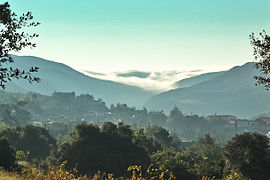Sournia
Sournia Sornià Sornhan | |
|---|---|
 A general view of Sournia | |
| Coordinates: 42°43′43″N 2°26′34″E / 42.7286°N 2.4428°E | |
| Country | France |
| Region | Occitania |
| Department | Pyrénées-Orientales |
| Arrondissement | Prades |
| Canton | La Vallée de l'Agly |
| Government | |
| • Mayor (2020–2026) | Yvon Crambes[1] |
Area 1 | 29.99 km2 (11.58 sq mi) |
| Population (2021)[2] | 486 |
| • Density | 16/km2 (42/sq mi) |
| Time zone | UTC+01:00 (CET) |
| • Summer (DST) | UTC+02:00 (CEST) |
| INSEE/Postal code | 66198 /66730 |
| Elevation | 380–1,234 m (1,247–4,049 ft) (avg. 500 m or 1,600 ft) |
| 1 French Land Register data, which excludes lakes, ponds, glaciers > 1 km2 (0.386 sq mi or 247 acres) and river estuaries. | |
Sournia (French pronunciation: [suʁnja] ; Catalan: Sornià; Occitan: Sornhan) is a commune in the Pyrénées-Orientales department in the Occitanie region of south-western France. Its inhabitants are known as Sourniannais.
Geography
[edit]Sournia is a town of the Fenouillèdes, the languedocienne part of the Pyrénées-Orientales, in the canton of La Vallée de l'Agly and in the arrondissement of Prades. The river Désix runs through the village. Sournia is 22 km from Ille-sur-Têt and from Vinça, 24 km from Prades and from Saint-Paul-de-Fenouillet, 30 km from Latour-de-France and 34 km from Axat.
The commune is covered by the quality wine standard AOC 'Côtes-du-Roussillon'.
Sournia is crossed by the long-distance footpath, GR 36.

Administration
[edit]The current mayor of Sournia is Paul Blanc, a senator, of the centre-right and right wing party UMP founded by Jacques Chirac.
Population
[edit]The population of Sournia in 2017 was 498 people. For some reason at the end of the 19th century, the population of Sournia seemed to have a reputation for having one of the longest longevity in France, even though this fact was not clearly verified.[3]
|
| ||||||||||||||||||||||||||||||||||||||||||||||||||||||||||||||||||||||||||||||||||||||||||||||||||||||||||||||||||
| |||||||||||||||||||||||||||||||||||||||||||||||||||||||||||||||||||||||||||||||||||||||||||||||||||||||||||||||||||
| Source: EHESS[4] and INSEE (1968–2017)[5] | |||||||||||||||||||||||||||||||||||||||||||||||||||||||||||||||||||||||||||||||||||||||||||||||||||||||||||||||||||
Places of interest
[edit]- Ruins of the former church of Saint-Michel from the tenth century.[6]
- The ancient church of Sainte-Félicité from the tenth and eleventh centuries.[6]
- Church of Arsa from the twelfth century.
- Saint-Michel
- Sainte-Félicité
- Saint-Laurent d'Arsa
- The apse, Saint-Laurent d'Arsa
See also
[edit]References
[edit]- ^ "Répertoire national des élus: les maires" (in French). data.gouv.fr, Plateforme ouverte des données publiques françaises. 13 September 2022.
- ^ "Populations légales 2021" (in French). The National Institute of Statistics and Economic Studies. 28 December 2023.
- ^ (in French) Fabricio Cardenas, Vieux papiers des Pyrénées-Orientales, Record de longévité à Sournia en 1897 , 3 January 2015
- ^ Des villages de Cassini aux communes d'aujourd'hui: Commune data sheet Sournia, EHESS (in French).
- ^ Population en historique depuis 1968, INSEE
- ^ a b Rush, Simon John Nowell (2022), The first Romanesque architecture of Conflent, Pyrénées-Orientales, France (66). Tradition, system and style. [Thesis] Volume 1 (text), especially pages 126-7; and Volume 2 (illustrations), especially Figures 70-87.


 French
French Deutsch
Deutsch






